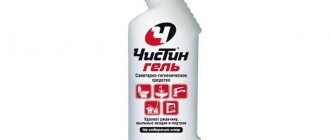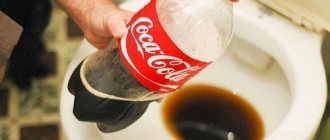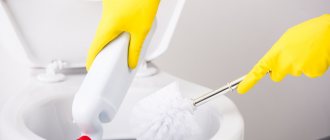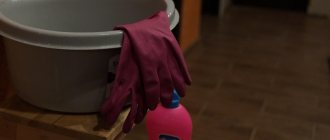A clean toilet is the key to health and order in the apartment. Housewives are looking for a product to not only clean it of limescale, but also to destroy bacteria that live under the rim and on the surface. Today, at a hardware store you can buy chemicals and preparations that keep the toilet bowl clean, or use folk remedies. In this article we will tell you how to remove limescale deposits in the toilet; what is better to use: strong acids or folk remedies.
Causes of toilet contamination
Limescale is also sometimes called waterstone; it is formed as a result of the deposition of salts contained in tap water.
As a rule, the yellowish coating is located precisely in the areas where the water is flushed, but sometimes it can be seen under the rim of the toilet bowl and on the lid. Without proper care of your plumbing, the limescale layer gradually builds up, making it difficult to remove. In addition to the toilet, you should periodically clean the bathtub and shower stall to remove this deposit.
Cleaning the toilet takes a couple of minutes a day
Urinary stones are made up of mineral components that are found in human urine. Deposits begin to form when residents regularly forget to flush the toilet. Another problem is rust - rusty stains also form in places where water is flushed.
In addition, other reasons for the appearance of deposits in the toilet can be noted:
- high concentration of salts in water;
- the presence of cracks and other damage on the walls of plumbing fixtures;
- faulty barrel.
Attention! Despite the fact that water and organic stones spoil the appearance of plumbing fixtures, deposits are an excellent breeding ground for microorganisms.
You can cope with this problem at home using available means. In difficult cases, when there is too much contamination, you will have to use chemicals.
To wash plumbing fixtures, you need to purchase thick gloves.
Recommendations
When starting to clean the toilet, you must follow the following recommendations from cleaning specialists:
- All work must be carried out wearing rubber gloves;
- to protect the respiratory tract from caustic fumes, you will need a mask;
- for regular surface treatment, it is recommended to use preparations in gel form, as they damage the material of the toilet bowl less and dissolve better in water;
- cleaning the toilet must be supplemented by washing the lid and seat;
- in extremely advanced cases, repeated treatment may be required if the complex plaque was not eliminated the first time.
All the most important and useful information on cleaning the toilet is presented in this section.
General rules for cleaning plumbing fixtures
Before you start washing your plumbing, you must do the following:
- Put gloves on your hands and cover your nose with a special mask. Any plumbing cleaning products dry out the skin and can release dangerous fumes that burn the respiratory tract.
- All water should be pumped out of the toilet. This can be done with any device - for example, a ladle, and wipe off any remaining moisture with a rag. This is done in order to increase the effectiveness of cleaning products.
It's comfortable! Instead of a ladle, it is recommended to use a special syringe for pumping out automobile oil. This device is often used by plumbers before repairing a toilet.
A syringe can be used to quickly and hygienically pump water out of the toilet.
What tools should I use to clean the toilet?
The following household appliances are usually used for cleaning plumbing:
- brush;
- a special sponge with a long handle;
- a cloth made of natural textiles.
When choosing a brush, it is necessary to take into account that it should not be too hard or iron, otherwise the surface of the walls of the toilet bowl will quickly be scratched and become unusable. Using a long-handled sponge, apply detergents to stones and plaque. Upon completion of the procedure, you must thoroughly wipe the walls with a cloth.
Sponge on an extended handle
Please note that when using any cleaning products, you must carefully study their composition and instructions. In addition, it is better not to use them at the same time - otherwise an unpredictable chemical reaction may occur.
In addition, you should not keep any product (even those based on natural ingredients) for longer than the prescribed time, because some substances contribute to the destruction of the toilet bowl coating.
Restoring the whiteness and freshness of the toilet using folk remedies
When an unpleasant odor appears in the bathroom and noticeable yellowish spots on the inner walls of the toilet, visiting the toilet becomes not very pleasant. The simplest way to clean a toilet from lime deposits involves using a brush. This device can be used to clean stains on the toilet. If the problem remains unresolved, you need to try more serious options, for example, folk remedies. With their help, you can try to clean minor and old deposits and answer the question of how to remove yellow deposits in a toilet connected to a plastic pipeline or local sewer system.
Removing thin and medium plaque
If the layer of plaque and urinary stones is not too thick, then you can get by with the help of folk remedies and gentle alkaline remedies.
Using soda and vinegar: step-by-step instructions
This is a powerful remedy that effectively dissolves stones of even medium thickness.
Step one: First you need to pour vinegar into a container and then heat it to a temperature of 38-39 degrees.
The vinegar must be hot
Step two: now you need to add soda (about 5-8 grams) to the hot vinegar.
Baking soda and vinegar will react
Step three: now this mixture must be poured into the toilet so that the stones and limescale are saturated. The composition must be left for 6-7 hours.
Paper napkins soaked in the solution should be placed in hard-to-reach places.
Step four: after a while, remove any remaining deposits using a brush.
Use a small brush to clean the toilet in hard-to-reach places
Step five: upon completion of the reading, you need to flush the toilet with water from the barrel.
There should be no deposits left on the surface
Video - How to clean a toilet without chemicals
Using citric acid: step-by-step instructions
This method can dissolve a thin layer of urinary stone or limescale. In addition, in this case there is no need to remove water from the toilet in advance.
Step one: first you need to pour 75 grams of citric acid into the toilet, then leave it for a couple of hours.
It is necessary to ensure that the powder covers all contaminants.
Step two: after the allotted time, you need to take a brush and forcefully wipe off all the dirt.
At the end of the procedure, the toilet must be rinsed with hot water.
Bleach against limescale: step-by-step instructions
In this case, it is necessary to use any product containing chlorine, including “Whiteness”. This method will not only cope with contamination, but will also eliminate pathogens.
Step one: first you need to pour all the bleach into the toilet. It is advisable to leave this remedy for 12 hours, so it is recommended to carry out the procedure at night.
It is necessary to close the toilet with a lid
Step two: in the morning you need to rinse the toilet with hot water.
If some dirt remains, you can clean it with a brush.
Using technical soda and baking soda: step-by-step instructions
This method will also help remove minor dirt from the surface of the plumbing fixtures.
Step one: first you need to mix baking soda and technical soda in one container.
Step two: then add water to get a porridge-like consistency.
This is what a stain treatment product should look like
Step three: now this product must be applied to toilet paper and applied pointwise to all stains. It is advisable to leave the toilet like this overnight.
In the morning you just need to wash off the product
Using a carbonated drink: step-by-step instructions
Carbonated drinks not only help dissolve yellow limescale, but also quickly remove rust.
How soda works on rust
Step one: you need to take a 2-liter bottle of Coca-Cola (or another) drink, and then pour the contents into the toilet.
The toilet should be left in this form for 8-9 hours.
Step two: when the soda dissolves all traces of plaque, you will need to thoroughly rinse the toilet with water and then clean it with a brush.
To enhance the effect, you can treat the plumbing with soda
Video - Cleaning the toilet with soda
Household chemicals
There are various household chemicals that effectively cope even with old stains. They contain an active substance - alkali, due to which they effectively break down organic and other mineral deposits. In addition, they allow you to disinfect the surface from pathogenic microorganisms.
Powders
These are effective means for cleaning the toilet from various contaminants, but their main disadvantage is the presence of abrasive particles that scratch the glossy surface of the plumbing fixtures. This problem leads to the fact that every year the condition of the toilet worsens and it becomes dirty faster, so you need to use powders as little as possible. For example, with their help, general cleaning of plumbing is carried out, and then cleanliness is maintained using more gentle means.
Table 1. List of popular powder products
| Title, illustration | Description |
| "Comet" | This is a universal cleaning powder that is suitable not only for plumbing fixtures, but also for tiles. It must be applied to a damp surface in an amount of 10-15 grams, after which the surface should be thoroughly rubbed with a brush. The maximum exposure time of the product is 8-10 minutes. |
| "Pemolux" | This powder contains soda and small marble chips, thanks to which it copes even with old stains. It is necessary to apply the optimal amount of powder to the surface, and then rub thoroughly, applying force. |
| "Chistin" | This product is intended for washing dishes, countertops, kitchen furniture and bathroom fixtures. It quickly dissolves urinary stones, plaque, and also removes unpleasant odor. According to the instructions, it should also be applied for no more than 10 minutes, and then rinse the toilet thoroughly with water. |
| "Biolan" | This is one of the most gentle powders for cleaning any surfaces, including the toilet. It consists of small abrasive particles that do not scratch the coating even with intense impact. According to the manufacturer's recommendation, leave the powder on the dirt for up to 8 minutes, then rinse with water. If there are old contaminants, the holding time can be increased. |
Prices for popular cleaning products for tiles, plumbing and pipes
Cleaning products for tiles, plumbing and pipes
Liquids
Such products should be left on traces of limescale for a few minutes and then washed off. There are many liquids for cleaning toilets, as a rule, in stores they are on the same shelf - you can compare several products.
One of the most effective cleaning products is Sanox. It is used both for cleaning plumbing fixtures and for clearing blockages in pipes. It quickly removes traces of limescale, rust, stones and fights staphylococcus.
The total exposure time of this product does not exceed 7 minutes. After which it is recommended to rinse the surface several times with running water.
Liquid cleaner "Sanox"
Gels
These are the most convenient products that are suitable for cleaning any dirt. The gels have a thick consistency, making them easy to apply to the walls of the toilet bowl or under the rim. On average, the exposure time of such substances is 25 minutes, after which you will need to thoroughly scrub the toilet with a brush and rinse with water.
Table 2. List of popular gels
| Title, illustration | Description |
| "Toilet duckling" | This gel contains hydrochloric acid (15%), thanks to which it copes with almost all types of bacteria and contaminants. Another advantage of the product is its convenient neck, which makes it possible to use it in hard-to-reach places. The gel does not act immediately, it must be left for about 35 minutes to effectively soften all stones and plaque. |
| "Domestos" | The main purpose of this gel is to disinfect surfaces, because it contains sodium hypochlorite. In addition, it helps eliminate strong odors. This gel must be applied liberally to the surface of the plumbing fixtures. Despite the fact that the manufacturer recommends leaving the product on for about 30 minutes, for severe stains it should be left overnight. In the morning, you only need to rinse the toilet to remove any remaining gel and plaque. |
Cleaning creams
They have a similar effect to liquid products or gels, but have a denser consistency. They should only be applied to contaminated areas, which can then be covered with toilet paper. Since creams contain gentle ingredients, they can be left on the plumbing for several hours.
The most effective of them is the Sif cleaning cream. It is enough to apply it to the surface in a minimal amount and leave for 40-45 minutes. Contaminants will be removed even without additional exposure, so it will be enough to flush the toilet with water.
Cleaning cream "Sif"
Tablets for the tank
These tablets are used to prevent the formation of water and urinary stones, because they help soften the water, and therefore are installed in the tank. Each time you rinse, you will see brightly colored water (usually green, blue or cyan), and if it becomes clear, you should replace the tablet. Another advantage of such devices is their pleasant aroma.
Using tablets will keep your toilet smelling pleasantly clean.
How to remove a thick layer of plaque and urinary stones?
If traditional methods and gentle alkaline remedies do not help to cope with deposits, then strong acids will come to the rescue. Of course, experts strongly recommend against using such products on an ongoing basis, as they destroy the coating of the plumbing fixtures.
Table 3. List of potent acids
| Title, illustration | Title, illustration |
| Oxalic acid | It is an acid of organic origin with moderate toxicity. This product was used to clean plumbing fixtures several decades ago. It quickly breaks down deposits on the walls of the toilet. You can purchase it at any store where building materials are available. Before use, you should carefully read the instructions and wear silicone gloves. Application: 1. Dissolve a small amount of acid in water. 2. Pour into the toilet and leave for 60-70 minutes. 3. Rinse several times with clean water. If there are old stains, you can apply dry acid to a wet rag and apply it to the area. |
| Orthophosphoric acid | This acid is of chemical origin, it quickly copes with organic mineral formations and rust. However, its main property is that the acid does not destroy plastic pipes. Application: 1. Pour 90 ml of acid into the tank and the toilet itself. 2. Wait about 20 minutes. 3. Rinse off the product under high water pressure and wipe the surface with a brush. |
| Hydrochloric acid | This is a product based on toxic components that dissolves any contaminants in a matter of minutes. However, it should be used carefully, otherwise it can cause harm to health - the acid fumes burn the respiratory tract. Application: 1. Apply acid evenly to dirt. 2. Wait 15 minutes. 3. Rinse the toilet with plenty of water. This cleaning method is absolutely not suitable for owners of plastic pipes. |
| Electrolyte | Battery electrolyte contains a caustic component - sulfuric acid, which quickly breaks down mineral deposits. You can find this product at an auto parts store. The electrolyte should be used by analogy with hydrochloric acid. It is recommended to keep it for about 10-12 minutes and then rinse with water. |
Using automotive electrolyte
Using automotive electrolyte, you can answer the question of how to remove yellow deposits from the toilet and make the surface of the toilet white and shiny. In addition, this product will help remove blockages in sewer pipes and get rid of rusty stains. The use of electrolyte is similar to the use of hydrochloric acid. However, it should be remembered that frequent treatments can cause damage to the enamel.
How to care for toilets made of different materials?
Each material has individual properties, so you need to familiarize yourself with them:
- Porcelain. Structures made from such material quickly deteriorate when using powders with abrasive particles, because they scratch a smooth surface. Use gels!
- Faience. It is not recommended to clean plumbing fixtures made of such material with hard brushes and wash with hot water, otherwise the possibility of cracks may occur.
- Polymer concrete. It is recommended to clean such toilets only with liquid substances and gels.
- Stainless steel. These are durable products that are not destroyed by aggressive alkali and boiling water, so there are no restrictions on their washing.
Earthenware sanitary ware
Prices for toilets, urinals, bidets
Toilets, urinals, bidets
Prevention of yellowness
In addition to the use of the previously mentioned special tablets, in order to prevent the formation of yellow plaque, you need to:
- Clean the toilet at least once a week.
- Rinse off with water after each use.
- Do not discard leftover fatty foods.
- Fix leaks in a timely manner.
The appearance of yellow spots on the toilet bowl and seat is due to the hard composition of the water and the accumulation of urinary stones. To clean such contaminants, professional detergents or folk remedies containing acids (orthophosphoric or hydrochloric) and soda are mainly used.
How to prevent the formation of plaque and urinary stones?
In order to keep your plumbing fixtures tidy, you must adhere to the following recommendations:
- At least once every 7 days, thoroughly clean the plumbing using household chemicals. The frequency of cleaning can be increased or decreased, depending on the number of residents in the apartment.
- It is necessary to monitor the serviceability of the tank. If it starts to leak, you need to make repairs or purchase a new one.
- The drain tank should be constantly filled with gentle detergents to prevent deposits.
- It is strictly forbidden to flush fat down the toilet after cooking.
As you can see, the rules for caring for plumbing are not complicated, but following them will prevent unpleasant problems.
Preventive control measures
Avoiding situations where the surface of the toilet requires cleaning of mineral deposits, or being in them as little as possible, helps preventive measures to combat such contamination, which include the following:
- Regular cleaning of the device, performed at least once every two weeks, using gentle products - special liquids and gels. The frequency with which such a procedure must be performed is determined by the number of regular users of such a plumbing device.
- With each drain, if necessary, you should use a brush to clean the surface of the device from any contaminants that have formed on it.
- Do not allow the drain tank to leak, carry out its repairs and adjustments in a timely manner.
- Use special tablets placed in the device’s drain tank and gel blocks secured under its rim.
Let's sum it up
When choosing a toilet care composition, it is necessary to take into account not only the material of the plumbing fixtures, but also the pipes - for example, plastic pipes “will not forgive” the use of aggressive acids. In addition, you should not wash the structure too often with chemical components, if you can get by with traditional ones - this way you will preserve the glossy surface for a long time.
Finishing the toilet with PVC panels will greatly simplify the improvement of the interior of the toilet. In a special article, we’ll look at how to finish wall panels in a bathroom, and we’ll also figure out how to choose the right material.











